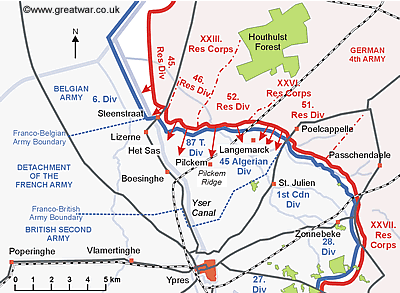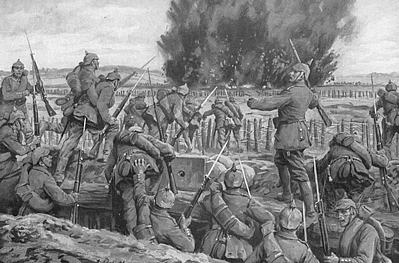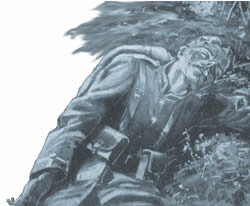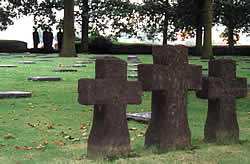 German soldiers describe the infantry advance
German soldiers describe the infantry advance
22 April 1915: 17.30
In a letter from the front a German soldier wrote about the attack. In the letter he states that he had thought he was fighting opposite English troops. However, as the British front line was not directly attacked at 5.15pm on 22 April, it can be assumed that the English casualties and captured English artillery he refers to are in fact French.
From his description of the “mixture of races” he came across in the Allied lines, it is believed that he may have been in 52. Reserve Division attacking through the boundary of the French territorials of 87th Division and the North African 45th Division.

He wrote:
“In a few minutes we were over - we lay down and opened fire... Mines, handbombs and handgrenades flew every which way. We jumped up and in a few steps were in the enemy trench, smashing any attempt at defence that we encountered... We pressed on and on; the first, second and third trench positions were overrun. Now we were in the main position and there were the guns of the artillery! Who would have thought that today we would have captured guns. Nine in total and brand spanking new guns. We had imagined the enemy's opposition to our attack would be very different and we were overjoyed that we were suffering relatively few casualties. Our artillery had done well to soften up the Frenchmen and the English.
In the captured positions the sight was pretty grotesque. Our heavy shells had torn huge craters in the earth. Shelters and bunkers were destroyed. In amongst the debris there were torn bodies and limbs of soldiers... There were not only white men lying dead, but we found black, brown, yellow and red. There was a complete mixture of races; Death had made a terrible harvest of them here. They all lay there, silent, stiff, most gruesomely ripped apart... Also, among the prisoners we took, there were many coloured troops who were visibly happy that they had been taken prisoner by the Germans and so escaped with their lives. We were amazed, because we had thought there were only English soldiers opposite us. Now we saw that we had been fighting against people of many different races. We had been victorious and the longed-for moment had come when the enemy trenches were in our possession. If they should come to take them back, we'll be waiting for them!” (1)

Leutnant Richard Drach, commander of the 4. Company in the 238 Reserve-Infanterie-Regiment described the advance of his company in the 52. Reserve Division sector. His regiment started the advance from the German front line north west of Langemarck. It was to head in a southerly direction passing close to the west side of Langemarck:
“It was with great difficulty that the Company got through the [enemy] artillery fire and moved forwards. We passed over abandoned French trenches. We passed by farms where Zouaves, Turks and elderly French soldiers stood with their hands up begging for mercy. Occasionally there was weak resistance, but this was quickly overcome. The landscape made an incredible impression on us. Trees, houses and the railway embankment [for the Boesinghe-Langemarck-Staden railway] appeared out of the mist. The air tasted sour. Our nerves were on edge for whatever might befall us. Sure enough, it came! Enemy artillery fire! But we already had 2 kilometres behind us. We had reached our first objective and we dug ourselves in. Everywhere there were signs of great confusion and a rushed departure. Everything was all over the place. In the last house we captured, coffee had only just been poured out into the cups.” (2)
Leutnant Becker of the III. Battalion, 238 Reserve-Infanterie-Regiment (52. Reserve Division) wrote of his experiences from the moment he and his men climbed out of the German front line trench to begin the advance:
“... suddenly everyone began to rush forward through the gaps in the wire and swarmed towards the enemy territory as though they were on the parade ground. Over in the enemy lines Frenchmen, Zouaves and Indochinese sat or lay on the ground, coughing and spitting. None had any thoughts of fighting back. For them the war was over... Swathes of the gas cloud, which had gleamed in the sun before us just now, began to swirl upwards, dancing around one another. Then the wind slowly carried the cloud into the enemy positions. Even when it was swirling around it put most of the enemy troops out of action in the front line positions.
I followed on behind the first soldiers to leave our trenches in the second wave. This was made up of the 9. and 10. Companies waiting in reserve close behind the front line. We moved forward at the double across the ground from our front line trench, making for the jumping off trench. I called out to the men, moving them away from where enemy artillery shells were falling. The two companies managed to clamber to our jumping off trench without losing any casualties. The companies then carried on at the double. They were under orders to follow on behind the first wave of infantry at a set distance. We then left the empty jumping off trench along with the battalion Staff, the messengers and the telephonists, hurrying after our comrades. The grass was trodden down, the air was full of the smell of gas ...

We hurried along a road which ran past the Candit Troere Farm to Ypres. Our pace slowed down when we came across a comrade [his name was Baum] lying at the side of the road. He was covered over with a coat and badly wounded. He was in the last stages of his fight with Death. I spoke to him but he couldn’t hear me. I stood beside him in an agonizing silence. It wasn’t long before he breathed his last breath. I squeezed his hand and wished him good speed on his way to eternal peace. He now lies with many other comrades in the cemetery at Langemarck ...” (3)
Next>> The Allied front line broken — the way to Ypres open
Related Link

By the end of the war there were several German military cemeteries in the area around Langemarck village. The cemetery that is there today is what is called a “collecting cemetery”, as it has been expanded in size from the original burial ground with graves brought in from the local area and also further afield after the war.
Langemarck German Military Cemetery
Acknowledgements
(1) Der Völkerkrieg, V. Band, p. 172-3
(2) Geschichte des Reserve-Infanterie-Regiments Nr. 238, p. 58
(3) Geschichte des Reserve-Infanterie-Regiments Nr. 238, pp. 56-58
(4) Painting by Alfred Roloff, taken from the German magazine 'Daheim!' (Heft 23) printed in early 1915